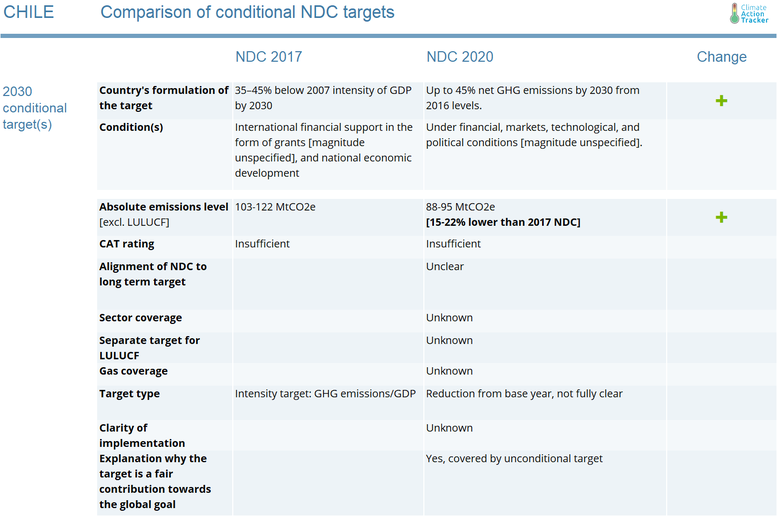Summary
Chile submitted NDC update
On 9 April 2020, the Chilean Government officially released its updated NDC, which is more ambitious than its first NDC submitted to the UNFCCC in 2017 and also slightly more ambitious than an earlier draft NDC of 2019. However, its projected emissions still fall in the ‘Insufficient’ CAT range. Chile needs to go even further if it aims to become compatible with the Paris Agreement’s 1.5° limit.
The updated NDC is stronger in various ways:
- The new NDC has a target of 95 MtCO2e in 2030, which is 2 MtCO2e lower than the earlier draft NDC and significantly lower than the emissions that would have resulted from the previous intensity target (131 MtCO2e)
- The new NDC includes a new goal to peak GHG emissions by 2025, two years earlier than the previous draft
- The new NDC includes a new GHG emissions budget until 2030, which is smaller than the original draft.
The updated NDC also contains a conditional target for 2030. This target was included in the draft released in October 2019, but the final submission contains no further details.
Chile’s Minister of the Environment, Carolina Schmidt, stated that ‘once the country overcomes the corona crisis, they will enter a rehabilitation phase which must be sustainable’, highlighting that the Chilean government recognises the importance of green economy recovery packages.
CAT analysis of unconditional target


The Chilean Government officially released its updated NDC on 9 April 2020, and it builds on a draft version released for public consultation in October 2019.
Chile’s updated unconditional targets has three components:
- An absolute, economy-wide target excluding emissions or removals from the Land Use, Land Use Change and Forestry (LULUCF) sector of 95 MtCO2e in 2030;
- A GHG emissions budget for the period from 2020 to 2030 that will not exceed 1100 MtCO2e;
- A 2025 peak year for GHG emissions.
The new NDC has a target of 95 MtCO2e in 2030 is significantly lower than the emissions that would have resulted from the intensity target of the first NDC (131 MtCO2e). The previous NDC did not include a peak year or a budget.
Chile has improved on each of the mitigation components compared to its October 2019 draft: the emissions cap has been reduced by 2MtCO2e in 2030 (97 compared to 95 MtCO2e), the emissions budget has been limited to 1110 MtCO2e, and the peak year has been brought forward by two years, from 2027 to 2025. While each of these improvements is a step in the right direction, these measures are not enough to improve the CAT rating of the 2019 NDC, which remains in the ‘Insufficient’ range.
The CAT estimates that by implementing all of its planned policies, Chile could reduce its emissions to 99 to 101 MtCO2e by 2030 (around 5 MtCO2e above the new target) and peak its emissions in 2023 (two years earlier than the 2025 date in its NDC update). Under this scenario the carbon budget between 2020 and 2030 would be 2-4% lower than the carbon budget presented in the NDC update document.
The updated NDC also includes separate targets for the LULUCF sector. These are more ambitious than in the previous NDC (but remain the same as the 2019 draft proposal):
- Sustainable management and recovery of 200 000 hectares of native forest (100 000 in previous NDC), equivalent to a GHG emissions capture between 0.9 and 1.2 MtCO2e/yr by 2030;
- Reforestation of 200 000 hectares of forest (100 000 in previous NDC), from which at least half correspond to permanent forest coverage, from which at least 70 000 hectares should be native species. This is equivalent to a GHG emissions capture between 3 and 3.4 MtCO2e/yr by 2030;
- Reduce emissions from deforestation and land degradation of native forest by 25% by 2030, taking average emissions between 2001-2013;
Chile will also undertake to identify peatlands and other wetlands as part of a national inventory by 2025 and develop standardised metrics to evaluate their mitigation capacity by 2030.
The NDC (and the proposal of 2019) clearly spells out Chile’s goal to achieve GHG neutrality by 2050. The previous NDC did not include such a goal, previous announcements were termed around carbon neutrality (not all greenhouse gases).
CAT analysis of conditional target
The submitted NDC contains a conditional 2030 target of up to 45% net GHG emissions reduction by 2030 from 2016 levels. The target is much more ambitious than the previous conditional intensity target, but remained unchanged from the October 2019 draft. No further details have been provided, making the target difficult to assess. The CAT’s original analysis of this target is available here.
Details of other supporting targets
Chile’s updated NDC includes a separate target for black carbon emissions. It has committed to reducing those emissions by at least 25% below 2016 levels by 2030. This is a stronger target than that proposed in the October 2019 draft, which had a target of between 10 to 25%. A black carbon emission reduction target was not included in Chile’s first NDC.
The reduction of black carbon emissions has substantial co-benefits for human health. However, reductions in black carbon are generally not additional to reductions in CO2 emissions, because large fractions of black carbon emissions stem from the same emission sources as CO2. Emission reduction policies therefore often reduce CO2 and black carbon simultaneously, and this is already included in calculations of the emissions reductions required to hold warming well below 2°C globally, like the “emissions gap” and “fair share” reductions (see the Fair Share section on the CAT country analysis for Chile).
Links
Stay informed
Subscribe to our newsletter


